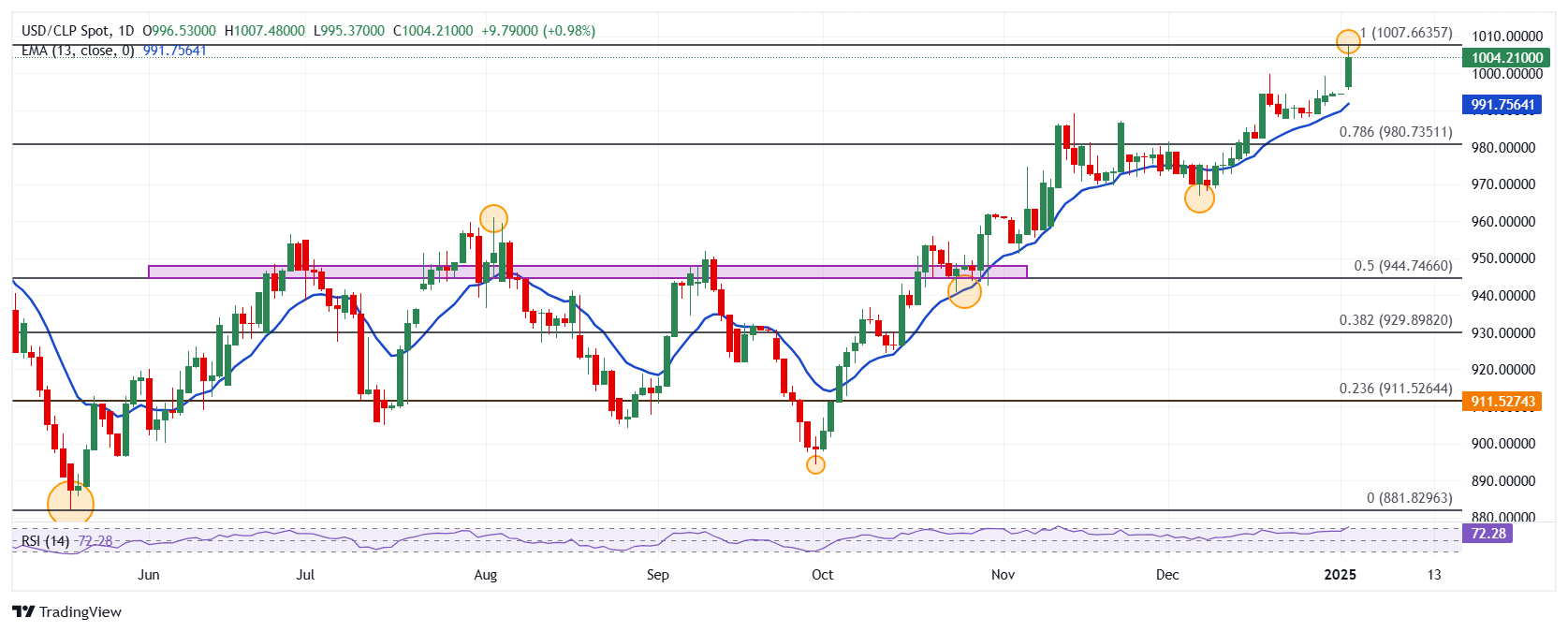- The Dollar rises 0.98% today against the Chilean Peso, signing its fourth consecutive session with gains.
- U.S. weekly jobless claims stood at 211,000, beating analysts’ expectations.
- The Monthly Index of Economic Activity of Chile (IMACEC) grew 2.1% in November compared to the same month of the previous year.
- Investors will focus their attention on the ISM Manufacturing PMI, which will be released tomorrow.
The USD/CLP set a daily low at 995.37 where it attracted aggressive buyers that pushed the pair to a high not seen since July 19, 2022. Currently, the USD/CLP trades above 1,004.21, gaining 0.98% on the day today.
The Chilean peso slides strongly after key economic data
According to the Central Bank of Chile, the Monthly Index of Economic Activity of Chile (IMACEC) registered an increase of 2.1% in November compared to the same month of 2023, although it is below the 2.3% reached in October.
On the other hand, weekly applications for unemployment benefits in the United States stood at 211,000 in the week ending December 27, below the 222,000 expected by the market and the 220,000 registered in the previous week.
Investors will focus on the US ISM manufacturing PMI, corresponding to December, which will be released on Friday and whose consensus analysts project at 48.4 units, equaling the November record.
Technical levels in the USD/CLP
USD/CLP reacted higher on short-term support given by the December 6 low at 966.89. We see the next key support at 940.90, the low of October 24 in convergence with the 50% Fibonacci retracement and supported by the 21-period exponential moving average. To the upside, we project profit taking at 1,050.00, a closed number that converges with the maximum of July 19, 2022.
USD/CLP Daily Chart

US Dollar FAQs
The United States Dollar (USD) is the official currency of the United States of America, and the “de facto” currency of a significant number of other countries where it is in circulation alongside local banknotes. According to 2022 data, it is the most traded currency in the world, with more than 88% of all global currency exchange operations, equivalent to an average of $6.6 trillion in daily transactions. After World War II, the USD took over from the pound sterling as the world’s reserve currency.
The single most important factor influencing the value of the US Dollar is monetary policy, which is determined by the Federal Reserve (Fed). The Fed has two mandates: achieve price stability (control inflation) and promote full employment. Your main tool to achieve these two objectives is to adjust interest rates. When prices rise too quickly and inflation exceeds the 2% target set by the Fed, the Fed raises rates, which favors the dollar. When Inflation falls below 2% or the unemployment rate is too high, the Fed can lower interest rates, which weighs on the Dollar.
In extreme situations, the Federal Reserve can also print more dollars and enact quantitative easing (QE). QE is the process by which the Fed substantially increases the flow of credit into a clogged financial system. This is an unconventional policy measure used when credit has dried up because banks do not lend to each other (for fear of counterparty default). It is a last resort when a simple lowering of interest rates is unlikely to achieve the necessary result. It was the Fed’s weapon of choice to combat the credit crunch that occurred during the Great Financial Crisis of 2008. It involves the Fed printing more dollars and using them to buy US government bonds, primarily from financial institutions. QE usually leads to a weakening of the US Dollar.
Quantitative tightening (QT) is the reverse process by which the Federal Reserve stops purchasing bonds from financial institutions and does not reinvest the principal of maturing portfolio securities in new purchases. It is usually positive for the US dollar.
Source: Fx Street
I am Joshua Winder, a senior-level journalist and editor at World Stock Market. I specialize in covering news related to the stock market and economic trends. With more than 8 years of experience in this field, I have become an expert in financial reporting.







